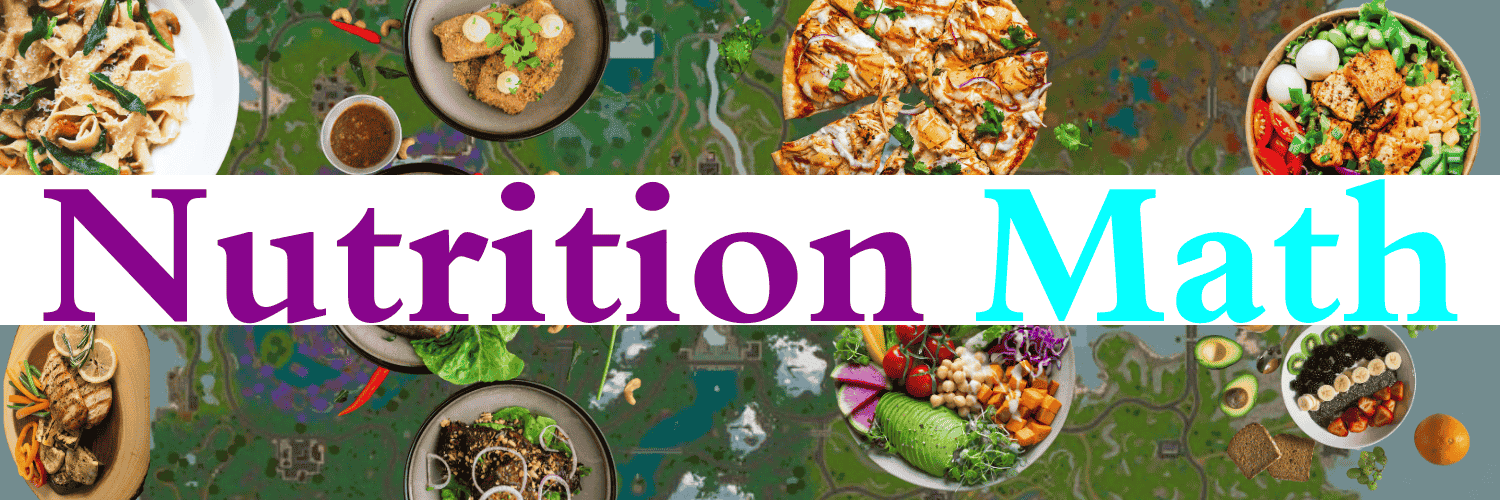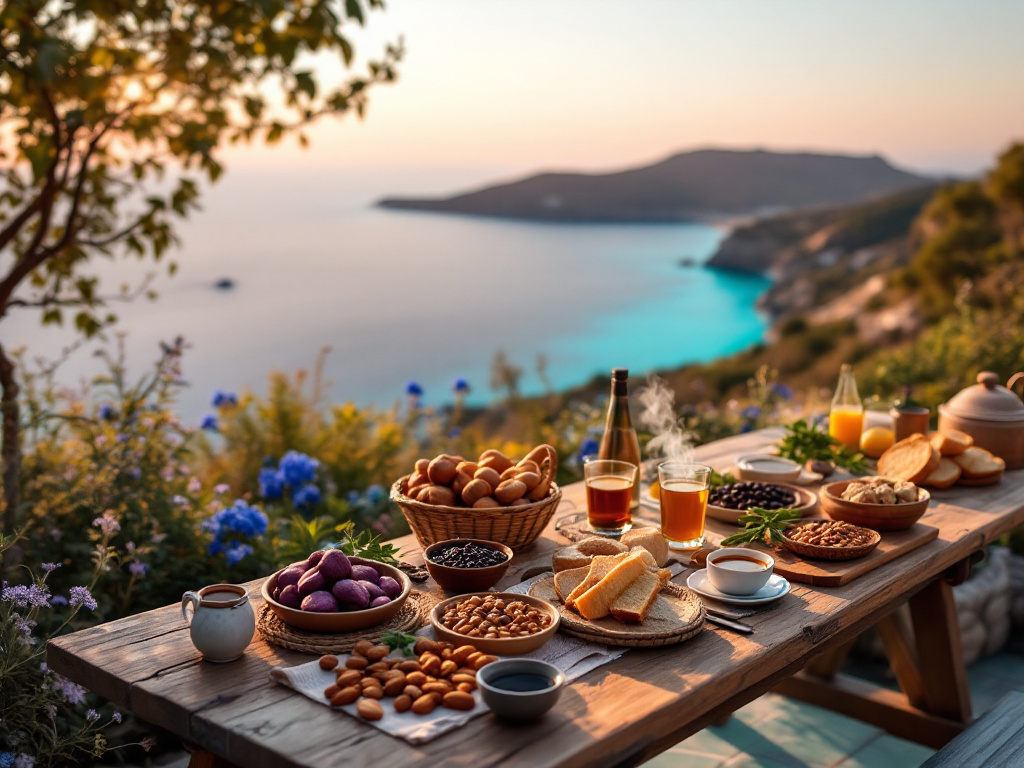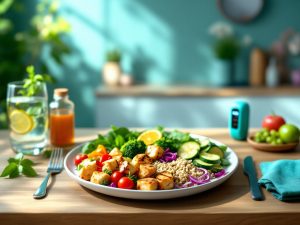Introduction
What if the key to a long, vibrant life isn’t buried in high-tech labs, pricey supplements, or cutting-edge gadgets, but simmering in the modest kitchens of a few overlooked places? The Blue Zones—Okinawa in Japan, Sardinia in Italy, Nicoya in Costa Rica, Icaria in Greece, and Loma Linda in California—showcase human endurance. Here, people don’t just survive into old age; they thrive, often passing 90 or 100 with keen minds and strong bodies. These aren’t flukes—they’re living lessons in nutrition and lifestyle, revealing how to extend life without dimming its spark.
The term “Blue Zones” emerged in the early 2000s when National Geographic explorer Dan Buettner and researchers mapped these hubs of exceptional longevity. They didn’t find reliance on modern medicine or fad diets, but a blend of time-honored habits—eating well, staying active, and connecting deeply—that have outlasted empires. From Okinawa’s coral shores to Sardinia’s rugged peaks, these communities don’t chase youth; they nurture vitality through simple food and shared moments. Their diets, varied yet aligned, defy our culture of excess, proving less can be more.
This is more than a food story—it’s a philosophy. Picture an Okinawan elder shaping tofu under cherry blossoms, a Nicoyan farmer shelling beans with grandkids, or a Sardinian shepherd sipping wine at sunset. These aren’t just charming scenes; they’re blueprints for resilience and joy. In our world of processed clutter and screen-bound lives, the Blue Zones call us back to basics—not with strict rules, but with practical, tasty wisdom. Their secret? Cutting through the noise. Ready to taste their lessons?
Here’s the twist: this isn’t out of reach. Habits born in remote villages can bloom in our cities and suburbs. They’re not about perfection, but possibility. The Blue Zones challenge us: what if longevity isn’t luck, but a garden we tend? Let’s see how their food fuels that growth.
Plants Take Center Stage
In the Blue Zones, plants don’t just support the meal—they run the show. Every dish blends vegetables, legumes, fruits, and whole grains, rooted in local harvests and human health. In Okinawa, the purple sweet potato, *beni imo*, stars—a humble root rich with anthocyanins, antioxidants that fight cellular wear. It’s joined by seaweed like kombu, bitter melon for detox, bamboo shoots for bite, and *goya* greens brimming with vitamins A and C. Fish or pork? A rare treat, maybe weekly, dwarfed by this plant parade.
Sardinia’s rocky interior hums a different tune, but plants still lead. *Pane carasau*, a thin whole-grain flatbread, pairs with fava beans, chickpeas, and lentils—legumes that powered shepherds through lean times. Add zucchini, tomatoes, wild fennel, and arugula, drizzled with olive oil’s healthy fats, for a meal that’s hearty yet light. Nicoya, on Costa Rica’s sunny peninsula, relies on the “three sisters”—corn, beans, and squash—a Mesoamerican staple. Picture a tortilla cradling black beans and roasted calabaza, brightened by mango or starfruit.
Icaria, a tiny Aegean island, serves Mediterranean flair: wild greens like purslane and *horta*, plus figs, olives, almonds, and grapes from ancient vines. Loma Linda’s Seventh-day Adventists opt for a vegetarian spread—walnuts, oats, quinoa, kale, and tofu—leaving meat behind. In every zone, meat’s a quiet note, letting plants sing loud.
- Okinawa: Sweet potatoes, seaweed, tofu, daikon, bitter melon, a hint of pork.
- Sardinia: Whole-grain bread, lentils, artichokes, tomatoes, eggplant, a touch of pecorino.
- Nicoya: Corn tortillas, pinto beans, squash, avocados, bananas, citrus.
- Icaria: Wild greens, olives, chickpeas, grapes, figs, a bit of goat cheese.
- Loma Linda: Nuts, seeds, quinoa, brown rice, spinach, berries.
Why plants? Fiber balances blood sugar and clears cholesterol, antioxidants like vitamin C and polyphenols tackle cell-aging free radicals, and anti-inflammatory compounds—like olive oil’s oleocanthal—curb chronic illness. Research confirms it: Mediterranean diets cut heart disease deaths by 25-30%, legumes reduce diabetes risk by 10%, and plant-based eating lowers cancer markers by 15%. In the Blue Zones, plants aren’t a phase—they’re a foundation.
History explains it. Okinawa’s isolation limited meat; Sardinia’s tough land favored grains; Nicoya’s farmers grew what worked. Scarcity shaped diets science now praises. They quietly defy our fast-food overload—burgers and sodas can’t compete. I tried Okinawan eating for a week—sweet potatoes, miso, greens—and felt lighter, clearer. No exotic superfoods; just real, local fare.
Imagine a plate where veggies shine, not hide. It’s sustainable—less land and water than meat—and affordable. No pricey smoothies or rare berries—just seasonal picks, cooked with care. The Blue Zones don’t chase trends; they set the bar.
Less Is More
Portion control in the Blue Zones isn’t a chore—it’s instinct. Okinawans follow *hara hachi bu*, a 2,500-year-old mantra meaning “eat until 80% full.” Picture a meal: a fist-sized sweet potato, a small bowl of miso soup with tofu and seaweed, a handful of *goya*—300-400 calories, nutrient-packed, satisfying without excess. Sardinians keep it simple: a slice of *pane carasau*, a ladle of minestrone with beans and greens, a sip of Cannonau wine—500 calories, max. Icarians enjoy lentil stew with bread and olives, rarely topping 600.
Compare that to our oversized norms: a 1,200-calorie burger combo, a 700-calorie frappuccino, a 1,000-calorie pizza slice. Nicoya’s farmers power through with *gallo pinto*—rice, beans, onion—plus squash and an egg, about 600 calories. Loma Linda’s Adventists start with oatmeal, nuts, and blueberries—400 calories—skipping the obesity tied to meat and sugar. The reward? Lean bodies, low diabetes, and lasting hearts.
Science backs this up. Nutrient-rich moderation triggers longevity genes like sirtuins, repairing DNA and slowing aging. Studies show cutting calories 10-15% boosts insulin sensitivity and cuts inflammation; another links it to longer telomeres, the DNA tips that guard lifespan. Blue Zoners don’t obsess over numbers—they eat just enough, a habit from leaner days.
History shaped it. Post-war Okinawa scraped by on 1,200 calories daily; Sardinia’s shepherds stretched harvests; Nicoya’s tropics taught thrift. I tried *hara hachi bu* after a holiday splurge—stopped at 80% for a week, lost a few pounds, slept better. It’s not sacrifice; it’s smart restraint.
This isn’t about going hungry—it’s about balance. Blue Zone plates are small but mighty, showing excess isn’t strength. In 2025, with “value” sizes and endless fries everywhere, this feels bold. It’s a nudge to rethink fullness, bite by bite.
Protein, but Make It Light
Blue Zone protein isn’t a meat fest—it’s a lean craft. Okinawa favors fish—mackerel, sardines, tuna—twice weekly, loaded with omega-3s that guard hearts and brains. Research ties omega-3s to a 15-20% lower death risk. Tofu and edamame fill in, light and adaptable. Sardinians rely on legumes—lentils in soups, chickpeas in salads, fava beans with greens—plus pecorino cheese from grass-fed sheep, calcium-rich without the heft. Nicoyans blend black beans with eggs or a rare chicken bite, keeping it easy.
Icaria’s fishermen net anchovies or octopus, paired with lentils or hummus from local chickpeas. Loma Linda’s Adventists thrive on walnuts, almonds, and sunflower seeds—studies show nut-eaters gain 2-3 years from healthy fats. Red meat? A rare guest—a Nicoyan wedding roast, a Sardinian holiday stew, an Okinawan New Year’s nibble. Daily protein leans on beans, fish, nuts—low inflammation, no cholesterol spike.
| Zone | Protein Source | Benefit | Example Dish | Frequency | Calories (per serving) |
|---|---|---|---|---|---|
| Okinawa | Fish, tofu | Omega-3s, low fat | Miso soup with fish | 2-3 times/week | 150-200 |
| Sardinia | Legumes, cheese | Fiber, calcium | Chickpea stew | Daily | 200-250 |
| Loma Linda | Nuts, seeds | Heart-healthy fats | Almond-crusted oatmeal | Daily | 200-300 |
| Nicoya | Beans, eggs | Protein, vitamins | Gallo pinto | Daily | 250-300 |
| Icaria | Fish, lentils | Anti-inflammatory | Lentil salad with fish | 3-4 times/week | 200-250 |
It’s rooted in the past. Okinawa’s fish came from coastal waters; Sardinia’s sheep roamed free; Nicoya’s beans grew close. Meat was a feast, not a norm. I swapped steak for lentils once—cheaper, tastier, no heavy aftermath. Science agrees: red meat raises mortality by 12%, plant proteins lower it by 8%.
This isn’t sparse—it’s savvy. Light protein sustains without strain, dodging meat-heavy risks like heart disease and cancer. In 2025, with lab-grown meat buzzing, the Blue Zones prove nature’s picks still rule.
Fermentation for the Win
Fermented Favorites:
- Okinawa: Miso, natto, pickled daikon, soy sauce—probiotic champs.
- Sardinia: Sourdough bread, pecorino cheese, fermented goat milk.
- Icaria: Herbal teas, goat yogurt, wild honey ferments, kefir.
- Nicoya: *Chicha* (corn brew), pickled mango, fermented palm sap.
- Loma Linda: Kombucha, sauerkraut, homemade kimchi.
Fermentation sparks a gut revolution—bacteria like lactobacillus boost immunity, ease inflammation, and lift mood via the gut-brain link. A healthy microbiome might be longevity’s quiet star.
Okinawa’s natto—a sticky soybean mash—tops rice at dawn, miso soup simmering with umami richness. Sardinia’s shepherds age pecorino in caves, its tang a point of pride. Icarians brew sage and thyme into antioxidant teas, sipped at dusk. Nicoya’s *chicha* bubbles with a mild kick, echoing ancient ways, while Loma Linda’s Adventists ferment kombucha or kraut, blending health with tradition. These aren’t trends—they’re treasures from necessity.
Why ferment? Before fridges, it preserved harvests—Okinawan pickles, Sardinian cheese. It also boosts nutrition: studies show fermented foods cut inflammation by 10-15% and sharpen mood and memory. I tried miso in soup—salty, warm, alive. Blue Zoners nailed this centuries ago; science is just catching up.
It’s simple alchemy—basic ingredients turned into gut gold. It’s cheap (a jar, some salt), flavorful, and potent. In 2025, with probiotic pills everywhere, the Blue Zones say: skip the hype, ferment your own.
It’s Not Just Food—It’s a Ritual
Eating in the Blue Zones is a slow, shared ritual, not a rushed task. Imagine a Sardinian family on a stone terrace, breaking *pane carasau* as wine flows, sunlight gilding their laughter. Okinawan elders share noodle bowls under cherry blossoms, stories swirling with tea. Nicoyans celebrate harvests with beans and tortillas, a guitar strumming nearby, while Icarians linger over fish and greens, waves crashing below. Loma Linda’s Adventists gather post-sermon, oatmeal and fruit a bond of faith and friendship.
This isn’t just nostalgia—it’s science. Social meals lower cortisol—stress ages us—and forge ties, a longevity boost. Research links strong connections to 5-7 extra years and ranks isolation as deadly as heavy smoking. Blue Zone meals stretch over hours—digestion slows, bonds deepen. Compare that to scarfing a sandwich at a desk or gulping coffee in traffic. Same calories, different worlds.
History built this. Okinawa’s villages relied on each other post-war; Sardinia’s clans stuck close; Nicoya’s farmers shared harvests. Community was survival. I hosted a Blue Zone dinner—lentils, bread, friends—and felt calmer, fuller, without overdoing it. In 2025, with loneliness rising, this is healing.
It’s not just who’s there—it’s the pace. No rush, no screens, just presence. Blue Zoners don’t eat to fill up; they eat to connect, celebrate, live. That’s the magic.
Key Takeaways
What We Can Learn:
- Eat Plants: 80-90% veggies, beans, grains, fruits—skip the processed junk.
- Keep It Moderate: Stop at 80%, ditch soda and fries, enjoy small, mighty bites.
- Lean Proteins: Beans, fish, nuts over beef—meat’s a treat, not a routine.
- Ferment It: Miso, yogurt, sourdough—gut health drives longevity.
- Make It Social: Share meals, linger, connect—fuel for body and spirit.
- Move Naturally: Walk, garden, dance—no gym required, just life.
- Hydrate Wisely: Water, tea, a splash of wine—drop the sugar traps.
- Season Simply: Herbs, spices, olive oil—not salt or syrup—for taste and health.
- Sleep Well: Blue Zoners rest deeply—food aligns with rhythms.
- Mind the Mind: Gratitude at meals, purpose in days—mental wellness counts.
Pro Tips: Trade a meat dish for lentils—cheap, simple. Host a Blue Zone potluck—beans, greens, talk. Try *hara hachi bu* for a week—feel lighter, sharper. Ferment at home—cabbage or tea. Walk after dinner. Longevity’s a puzzle—start fitting it together.
These aren’t rules—they’re openings. Okinawa’s tofu meets Nicoya’s beans, but the core stays: whole, simple, shared. I began with beans and walks—energy rose, stress fell. In 2025, amid tech noise, this anchors us.
Conclusion
The Blue Zones don’t peddle miracles or trendy fixes—they offer a quiet truth: longevity is balance, not overload. Whole plants, modest bites, light proteins, fermented gems, and shared tables have carried centenarians through tough times. Science echoes it: Mediterranean diets slash heart risk by 30%, nuts add years, bonds outshine pills. These aren’t oddities—they’re guides, adaptable from rural hills to urban homes. Picture Okinawan sweet potatoes steaming, Sardinian bread crisping, Nicoyan beans simmering—then make it yours.
This isn’t about reaching 100—it’s about thriving today. Blue Zoners don’t chase youth; they craft vitality, bite by bite, laugh by laugh. I tried it—lentils for lunch, tea with a friend—and felt lighter, brighter. It’s not exclusive; it’s elemental—open to anyone with a pot and a table. Start small: a bean stew, a shared meal, a dusk stroll. Their wisdom isn’t old—it’s alive for 2025 and beyond.
Think about it: they ate from need—scarcity, soil, seasons. We eat from plenty—stores, apps, ads—yet stumble. In 2025, with AI diets and lab meat, the Blue Zones cut through: simplicity beats hype. They didn’t need tech; they had community, land, hands. What if we chose that too? A meal, a moment, a step—longevity’s not a goal; it’s a path. What’s your first bite?
A final note: this hits home. My grandma lived to 93 on beans, greens, and family dinners. The Blue Zones mirror her table. Maybe they’ll mirror yours. Let’s eat like we plan to stay.
Bringing Blue Zone Wisdom Home
You don’t need to live in a remote village to live long and well. Start small—cook beans, eat slower, invite friends to the table. That’s the real Blue Zone lifestyle. Which habit will you try first?




